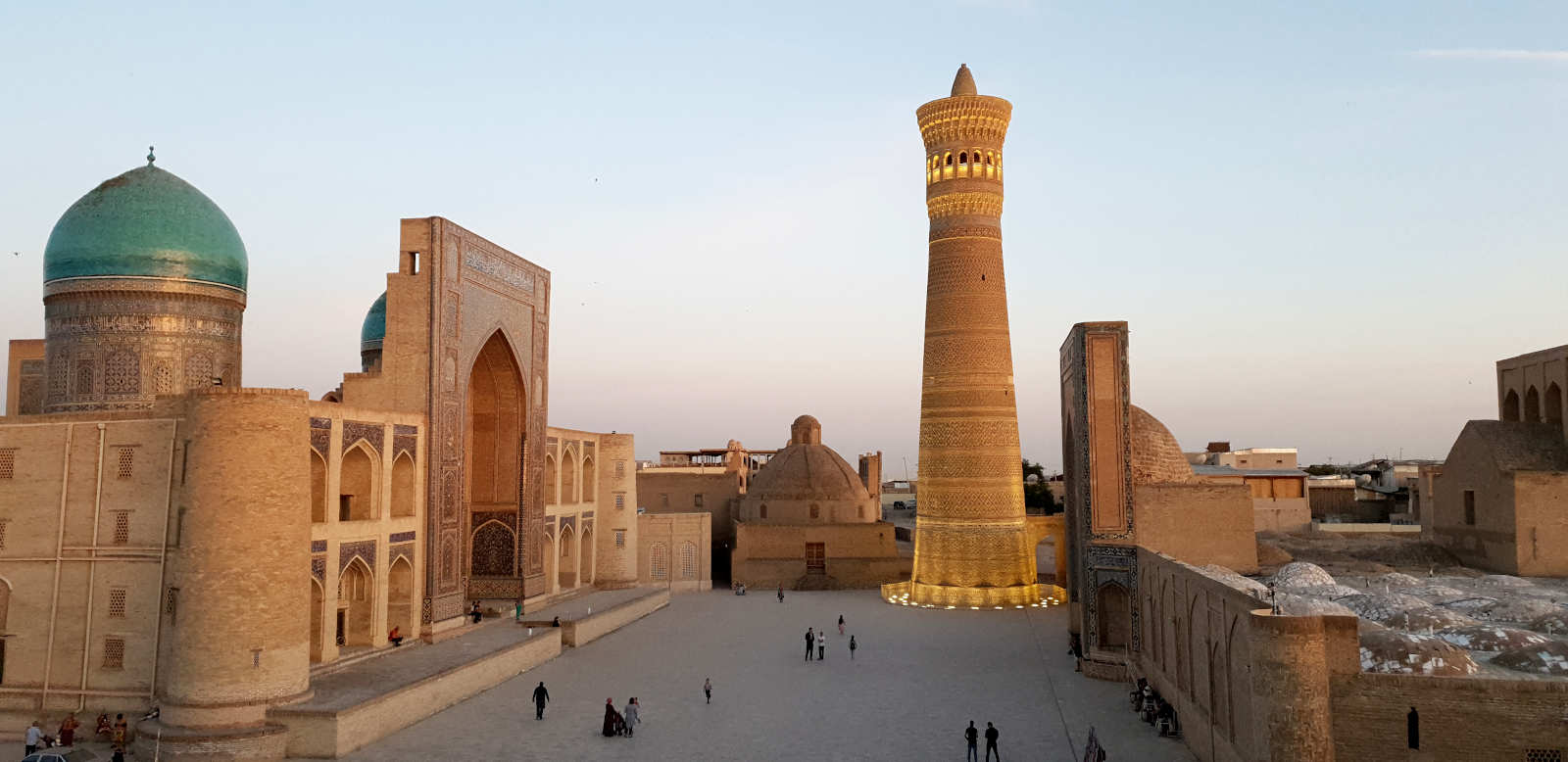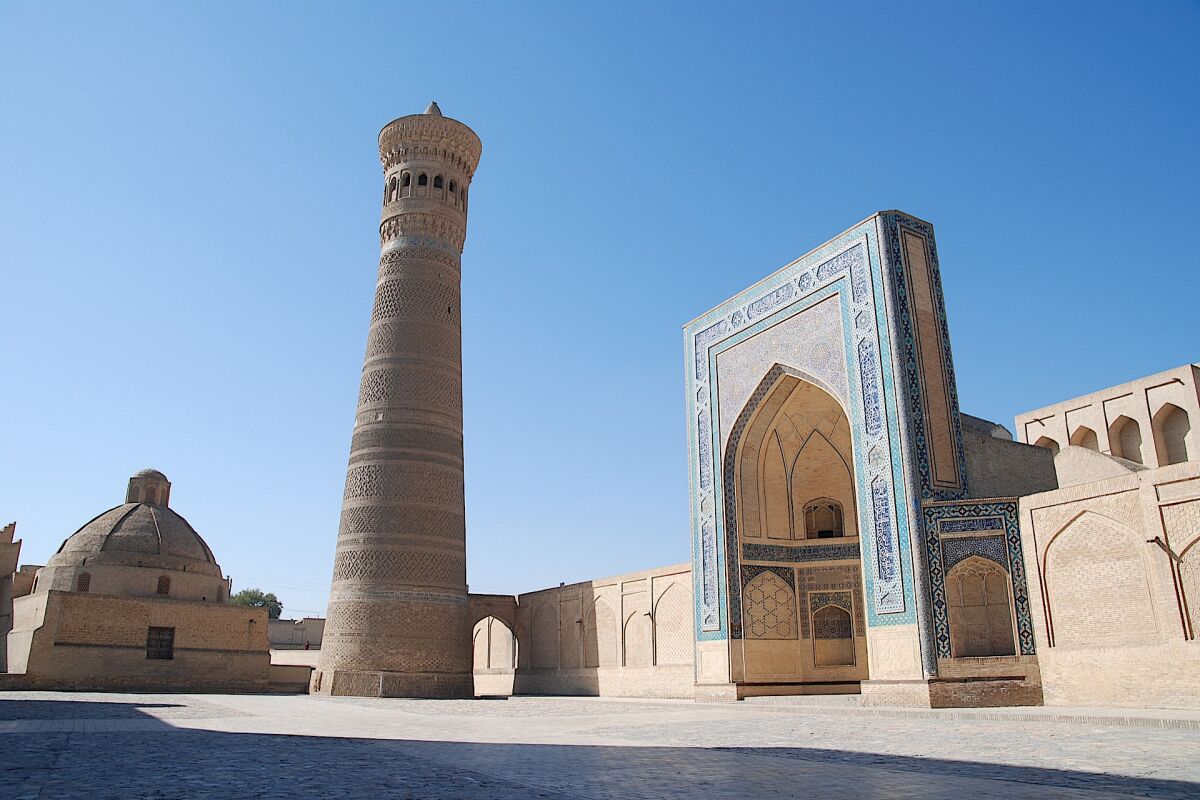Bukhara - Kalon Minaret

The Kalon Minaret in Bukhara: a masterpiece of Islamic architecture
For over eight centuries, the Kalon Minaret has risen majestically above ancient Bukhara and characterises the unmistakable silhouette of the city. This impressive structure, which can be seen from afar, has become the symbol of holy Bukhara and has proclaimed the greatness of the Islamic faith since its construction.
The Kalon Minaret, which means ‘Great Minaret’, is part of the central ensemble Poi-Kalon (‘At the Foot of the Great’), which in addition to the minaret also includes the Kalon Mosque (15th-16th century), the Miri-Arab Madrasah (16th century) and the Amir Alim Khan Madrasah (early 20th century). This ensemble forms the cultural and spiritual heart of Bukhara.
The history of the Kalon Minaret dates back to the early 10th century, when the city’s first minaret was built in the years 918-919. By order of the Karakhanids under Arslan Khan, this earlier minaret was demolished in the 1120s and replaced by the current structure. Numerous legends surround the minaret of Arslan-Khan – one says that its top was on the plain of Samarkand.
Today’s Kalon Minaret in Bukhara was built in 1127 by the master builder Ustod Baqi, whose name is closely associated with a fascinating legend: in order to preserve the secret of minaret construction, Baqi is said to have been prepared to sacrifice his life and only pass on his knowledge to his most loyal students. The result of his masterful work has been preserved to this day and fascinates visitors from all over the world.
The minaret is a masterpiece of medieval engineering and Islamic architecture. It was built entirely from fired bricks with a fine bond and has the shape of a slender round tower. With a total height of 45.5 metres and a diameter of 9 metres at the base, tapering to 6 metres at the top, it was not only a call to prayer, but also served as an orientation and watchtower.
The Kalon Minaret also impresses with its elegant decoration. The bricks are arranged in elaborate patterns that contain both geometric shapes and calligraphic elements. These decorations give the building a special dynamic and create a fascinating interplay of light and shadow that constantly changes throughout the day.
The minaret is an integral part of the Poi-Kalon ensemble, which is harmoniously embedded between the Kalon Jome Mosque (the cathedral mosque) and the Miri Arab Madrassa. On the third side of the ensemble, the square is completed by another minaret and a vaulted library hall. Together, these buildings form one of the most important central squares in Bukhara and a place of profound spiritual and cultural significance.
The Kalon Minaret has survived the centuries almost intact and is now considered one of the most perfect works of Islamic architecture. Its robust construction and timeless beauty make it a landmark of Bukhara that keeps the city’s past alive and amazes its visitors.
The Kalon Minaret, one of the most impressive buildings in Bukhara, rises majestically into the sky and bears witness to the high level of architecture and engineering of the 12th century. The surface of the minaret is decorated with twelve ornate strips of geometric ornamentation, some of which contain Kufi inscriptions. The inscriptions reveal the year of construction – 1127 – and the name of the architect – Baqi.
A legend surrounds the construction of this imposing tower: after Baqi had laid the foundations, he suddenly disappeared and only reappeared when the mortar had hardened. He feared that the khan would rush the construction and risk a collapse, as had happened during an earlier construction attempt in 1121.
Inside the minaret, a narrow spiral staircase with 104 steps winds its way up to the lantern – a round gallery with 16 arched windows decorated with ornate stalactites. Originally, there was another section above the lantern, of which only the base of the central pivot point remains today. The modern superstructure that can be seen here today was erected during later restoration work.
The Kalon Minaret also has a darker nickname: ‘Tower of Death’. In times gone by, it served as a place of execution – condemned prisoners were thrown to their deaths from the platform.
The history of the minaret is characterised by destruction and reconstruction. The upper part of the building was damaged in 1920 during artillery fire and aerial bombardment by the Red Army, but thanks to careful restoration work it was restored to its original splendour.
The architecture of the Kalon Minaret is unique in its monumentality. Despite its massive construction, the tower appears balanced and elegant thanks to its delicate ornamentation and harmonious proportions. Particularly remarkable is the stability of the building, which has withstood numerous earthquakes over the centuries that have destroyed many other buildings in the region. The secret of this stability lies in the empirically calculated proportions, the solid foundation construction and the high quality of the masonry.
The Kalon Minaret is connected by a bridge to the roof of the Kalon Jome Mosque, also known as the Mosque-Cathedral of Bukhara. From here you can access the interior of the minaret and climb the narrow, steep brick staircase with its 105 steps that leads up to the rotunda.

The rotunda offers a breathtaking view of the old town of Bukhara. You can recognise the silhouettes of the historic buildings and feel the breath of bygone times wafting through the narrow alleyways and over the centuries-old walls.
The Kalon Minaret remains a symbol of Bukhara’s architectural masterpiece and cultural heyday to this day. It attracts admirers from all over the world and stands as a cautionary monument to the transience of time and the permanence of human endeavour.
